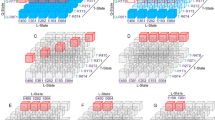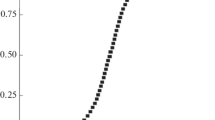Summary
The allosteric effects of the erythrocytic nucleoside triphosphates (NTP) and of proton concentrations were investigated by precise measurement of Hb−O2 equilibria of tench hemoglobin (including extreme, high and low saturation ranges) and analysed in terms of the MWC two state model and the Adair four step oxygenation theory.
At low concentrations (NTP/Hb ratio=1.0, and pH>7.3) ATP, GTP and protons decrease Hb−O2 affinity by increasing the allosteric constantL and reducingK T, the association constant1 of the deoxy, tense state of the Hb, without significantly affecting that (K R) of the oxy state, increasing the free energy of cooperativity (ΔG). High concentrations of these effectors, however, also reduceK R. The greater sensitivity of the half-saturation O2 tension (P 50) of the Hb to GTP than to ATP at the same concentration, correlates with greater effects of GTP on bothK T andK R. The pH and NTP dependence of the four Adair association constants and the calculated fractional populations of Hb molecules in different stages of oxygenation show that the autochthonous NTP effectors and protons stabilize the T structure and postpone the T→R transition basic to cooperativity in fish Hb.
The possible implications of the findings for aquatic respiration are discussed.
Similar content being viewed by others
Abbreviations
- ATP :
-
adenosine triphosphate
- DPG :
-
2,3-diphosphoglycerate (glycerate-2,3-bisphosphate)
- GTP :
-
guanosine triphosphate
- IHP :
-
inositol hexaphosphate
- NTP :
-
nucleoside triphosphates
References
Adair GS (1925) The hemoglobin system. IV. The oxygen dissociation curve of hemoglobin. J Biol Chem 63: 529–545
Arnone A, Perutz MF (1974) Structure of inositol hexaphosphate human deoxyhaemoglobin complex. Nature 249: 34–36
Berman M, Benesh R, Benesh RE (1971) The removal of organic phosphates from hemoglobin. Arch Biochem Biophys 145: 236–239
Bartlett GR (1978) Water soluble phosphates in fish red cells. Can J Zool 56: 870–877
Chien JCW, Mayo KH (1980) Carp hemoglobin I. Precise oxygen equilibrium analysis according to the models of Adair and of Monod, Wyman and Changeux. J Biol Chem 255: 9790–9799
Duggleby RC (1981) A non-linear regression program for small computers. Analyt Biochem 110: 9–18
Ferry MF, Green AA (1929) Studies in the chemistry of hemoglobin. III. The equilibrium between oxygen and hemoglobin and its relation to changing hydrogen ion activity. J Biol Chem 81: 175–203
Geoghegan WD, Poluhowich JJ (1974) The major erythrocytic organic phosphates of the American eel,Anguilla rostrata. Comp Biochem Physiol 49B: 281–290
Gillen RG, Riggs A (1977) The enhancement of the alkaline Bohr effect of some fish hemoglobins with adenosine triphosphate. Arch Biochem Biophys 183: 678–685
Gronenborn AM, Clore GM, Brunori M, Giardina B, Falcioni G, Perutz MF (1984) Stereochemistry of ATP and GTP bound to fish hemoglobins. A transfer nuclear Overhauser enhancement,32P-nuclear magnetic resonance, oxygen equilibrium and molecular modelling study. J Mol Biol 178: 731–742
Imai K (1973) Analyses of oxygen equilibria of native and chemically modified human adult hemoglobins on the basis of Adair's stepwise oxygenation theory and the allosteric model of Monod, Wyman and Changeux. Biochemistry 12: 798–808
Imai K (1982) Thermodynamic aspects of homotropic and heterotropic ligand binding by hemoglobin. In: Chien Ho (ed) Hemoglobin and oxygen binding. Elsevier North Holland, Inc., pp 169–175
Imai K, Yonetani T (1975) pH dependence of the Adair constants of human hemoglobin. Nonuniform contribution of successive oxygen bindings to the alkaline Bohr effect. J Biol Chem 250: 2227–2231
Jensen FB (1986) Pronounced influence of Hb−O2 saturation on red cell pH in tench blood in vivo and in vitro. J exp Zool 238: 119–124
Jensen FB, Weber RE (1982) Respiratory properties of tench blood and hemoglobin. Adaptation to hypoxic-hypercapnic water. Mol Physiol 2: 235–250
Jensen FB, Weber RE (1985a) Proton and oxygen equilibria, their anion sensitivities and interrelationships in tench hemoglobin. Mol Physiol 7: 41–50
Jensen FB, Weber RE (1985b) Kinetics of the acclimational responses of tench to combined hypoxia and hypercapnia. I. Respiratory responses. J Comp Physiol B 156: 197–203
Jensen FB, Weber RE (1987) Thermodynamic analysis of precisely measured oxygen equilibria of tench (Tinca tinca) hemoglobin and their dependence on ATP and protons. J Comp Physiol B 157: 137–143
Johansen K, Lykkeboe G, Weber RE, Maloiy GMO (1976) Respiratory properties of blood in awake and estivating lungfish,Protopterus amphibius. Repir Physiol 27: 335–345
Lykkeboe G, Johansen K, Maloiy GMO (1975) Functional properties of hemoglobins in the teleostTilapia grahami. J Comp Physiol 104: 1–11
Minton AP, Imai K (1974) The three state model: A minimal allosteric description of homotropic and heterotropic effects in the binding of ligands to hemoglobin. Proc Natl Acad Sci USA 71: 1418–1421
Monod J, Wyman J, Changeux J-P (1965) On the nature of allosteric transitions: A plausible model. J Mol Biol 12: 88–118
Perutz MF (1976) Structure and mechanism of haemoglobin Br Med Bull 32: 195–208
Perutz M, Brunori M (1982) Stereochemistry of cooperative effects in fish and amphibian hemoglobins. Nature 299: 421–426
Rapoport S, Guest GM (1941) Distribution of acid soluble phosphorus in the blood cells of various vertebrates. J Biol Chem 138: 269–282
Sharanov YA, Sharanov NA (1976) On the allosteric transition between structures of high and low ligand affinity in carp hemoglobin. Biochim Biophys Acta 446: 547–553
Sick H, Gersonde K (1969) Method for continuous registration of O2 binding curves of haemoproteins by means of a diffusion chamber. Analyt Biochem 32: 362–376
Tan AL, Noble RW (1973) The effect of inositol hexaphosphate on the allosteric properties of carp hemoglobin. J Biol Chem 248: 7412–7416
Tyuma I, Imai K, Shimizu K (1971) Effect of inositol hexaphosphate and other organic phosphates on the cooperativity in oxygen binding in human hemoglobins. Biochim Biophys Res Commun 44: 682–686
Tyuma I, Imai K, Shimizu K (1973) Analysis of oxygen equilibrium of hemoglobin and control mechanism of organic phosphates. Biochemistry 12: 1491–1498
Walaas E (1958) Stability constants of metal complexes with mononucleotides. Acta Chem Scand 12: 528–536
Weber RE (1981) Cationic control of O2 affinity in lugworm erythrocruorin. Nature 292: 386–387
Weber RE (1982) Intraspecific adaptation of hemoglobin function in fish to oxygen availability. In: Addink ADF, Spronk N (eds) Exogenous and endogenous influences on metabolic and neural control. Pergamon Press, Oxford, pp 87–102
Weber RE, Cox RP (1984) Effects of protons and nucleoside triphosphates (NTP) on hemoglobin-oxygen affinity in fish. Acta Physiol Scand 121: 5A
Weber RE, DeWilde JAM (1975) Oxygenation properties of hemoglobins from the flatfish plaice (Pleuronectes platessa) and flounder (Platichthys flesus) J Comp Physiol 101: 99–110
Weber RE, Johansen K (1979) Oxygenation-linked binding of carbon dioxide and allosteric phosphate cofactors by lungfish hemoglobin. In: Gilles R (ed) Animals and environmental fitness. Pergamon Press, Oxford, pp 49–50
Weber RE, Lykkeboe G (1978) Respiratory adaptations in carp blood. Influences of hypoxia, red cell phosphates, divalent cations and CO2 on hemoglobin-oxygen affinity. J Comp Physiol 128: 127–137
Weber RE, Lykkeboe G, Johansen K (1975) Biochemical aspects of the adaptation of hemoglobin-oxygen affinity of eels to hypoxia. Life Sci 17: 1345–1350
Weber RE, Lykkeboe G, Johansen K (1976a) Physiological properties of eel hemoglobin: Hypoxic acclimation, effects of phosphates and multiplicity. J Exp Biol 64: 75–88
Weber RE, Wood SC, Lombolt JP (1976b) Temperature acclimation and oxygen binding properties of blood and multiple haemoglobins of rainbow trout. J Exp Biol 65: 333–345
Wood SC, Johansen K (1972) Adaptation to hypoxia by increased HbO2 affinity and decreased red cell ATP concentration. Nature 237: 278–279
Author information
Authors and Affiliations
Additional information
In this paperK T andK R are defined as theassociation equilibrium constants instead of dissociation constants (as originally defined by Monod et al. 1965) to facilitate comparison with the Adair constants
Rights and permissions
About this article
Cite this article
Weber, R.E., Jensen, F.B. & Cox, R.P. Analysis of teleost hemoglobin by Adair and Monod-Wyman-Changeux models. J Comp Physiol B 157, 145–152 (1987). https://doi.org/10.1007/BF00692358
Accepted:
Issue Date:
DOI: https://doi.org/10.1007/BF00692358




